- Home
- About
- Map
- Trips
- Bringing Boat West
- Migration West
- Solo Motorcycle Ride
- Final Family XC Trip
- Colorado Rockies
- Graduates' XC Trip
- Yosemite & Nevada
- Colorado & Utah
- Best of Utah
- Southern Loop
- Pacific Northwest
- Northern Loop
- Los Angeles to NYC
- East Coast Trips
- 1 Week in Quebec
- Southeast Coast
- NH Backpacking
- Martha's Vineyard
- Canadian Maritimes
- Ocracoke Island
- Edisto Island
- First Landing '02
- Hunting Island '02
- Stowe in Winter
- Hunting Island '01
- Lake Placid
- Chesapeake
- Provincetown
- Hunting Island '00
- Acadia in Winter
- Boston Suburbs
- Niagara Falls
- First Landing '99
- Cape Hatteras
- West Coast Trips
- Maui
- Mojave 4WD Course
- Colorado River Rafting
- Bishop & Death Valley
- Kauai
- Yosemite Fall
- Utah Off-Road
- Lost Coast
- Yosemite Valley
- Arizona and New Mexico
- Pescadero & Capitola
- Bishop & Death Valley
- San Diego, Anza Borrego, Joshua Tree
- Carmel
- Death Valley in Fall
- Yosemite in the Fall
- Pacific Northwest
- Utah Off-Roading
- Southern CA Deserts
- Yosemite & Covid
- Lake Powell Covid
- Eastern Sierra & Covid
- Bishop & Death Valley
- Central & SE Oregon
- Mojave Road
- Eastern Sierra
- Trinity Alps
- Tuolumne Meadows
- Lake Powell Boating
- Eastern Sierra
- Yosemite Winter
- Hawaii
- 4WD Eastern Sierra
- 4WD Death Valley +
- Southern CA Deserts
- Christmas in Tahoe
- Yosemite & Pinnacles
- Totality
- Yosemite & Sierra
- Yosemite Christmas
- Yosemite, San Diego
- Yosemite & North CA
- Seattle to Sierra
- Southwest Deserts
- Yosemite & Sierra
- Pacific Northwest
- Yosemite & South CA
- Pacific Northwest
- Northern California
- Southern Alaska
- Vancouver Island
- International Trips
- Index
- Tips
- Books
- Photos/Videos
- Search
- Contact
Yosemite National Park, CA
Thursday, August 14, 2014 - 5:45am by Lolo
230 miles and 5.5 hours from our last stop - 12 night stay
Travelogue
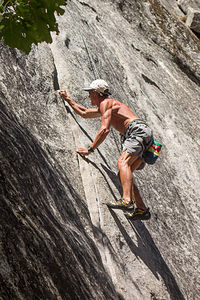 Herb ClimbingDespite our stressful arrival, it’s hard not to be relaxed and happy in Yosemite. It truly is, in my opinion, the most beautiful place in the U.S., and that’s saying a lot.
Herb ClimbingDespite our stressful arrival, it’s hard not to be relaxed and happy in Yosemite. It truly is, in my opinion, the most beautiful place in the U.S., and that’s saying a lot.
Also, with its tremendous rock climbing and hiking opportunities, it was the perfect place to meet up with our very adventurous and energetic sons. who had moved to the West Coast the previous summer. Rock climbing has become a bit of a family activity for us, and much of our vacations together are now centered around rock climbing destinations.
In preparation for their arrival later that night, Herb and I decided to use our “Yosemite Sport Climbs and Top Ropes” book, which we had bought here last Thanksgiving, to scout out potential rock climbing areas for the week. Herb and the boys have a preference for what is known as “sport” climbing, so it is a bit of a challenge finding these types of routes in what is really a “trad” climbing mecca.
Bikes are a great way to get around the valley, especially in August when the car traffic is awful, so we spent a really pleasant day riding the 12 miles around the Valley floor stopping at potential climbing areas and our favorite viewpoints along the way.
I spent a lot of time that day at the base of cliffs, straining to match the picture and description of climbs in the book with the sheer granite wall rising above me; and then visualizing my offspring scaling up it. As a mother, I was very highly motivated to find climbs that were “just right,” which meant “sport or top rope,” 5.9 to 5.11a range of difficulty, and some degree of shade during the day. The shade part is really important in August, because the mid-90 temps can heat up the rock in the sun, so much that you can practically fry an egg on it.
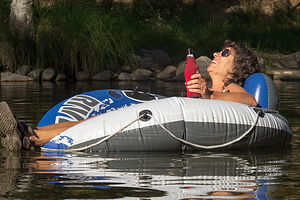 Lolo Demonstrating Proper Use of the TubeI think they were proud of me, because Herb and I pretty much came up with the same conclusions as they did from reading the climbing guides before their arrival. Our picks for the week included such interesting names as Swan Slab, Church Bowl, Manure Buttress Pile (my personal favorite – name that is), and Glacier Point Apron.
Lolo Demonstrating Proper Use of the TubeI think they were proud of me, because Herb and I pretty much came up with the same conclusions as they did from reading the climbing guides before their arrival. Our picks for the week included such interesting names as Swan Slab, Church Bowl, Manure Buttress Pile (my personal favorite – name that is), and Glacier Point Apron.
Even for those not scouting out climbing areas for their offspring, I highly recommend the bike ride around the Valley. You can cover a lot more ground than walking while at the same time avoiding sitting in traffic in your car.
That evening we just relaxed around the camp site talking to our neighbors, some of which were campground volunteers whose job it was to stroll the campground at night with bean bag guns to shoot at black bears that got a little too comfortable with spending time in the campground. They really did this, because sure enough, every night we were there we heard at least two or three gunshots go off during the night. It’s time like this that I am very grateful that I am sleeping in my hard-sided Lazy Daze rather than a tent. Actually, I think I am always grateful for that.
Herb fell asleep around 10:00, but I was too excited about the kids’ arrival to go to bed yet. They finally pulled in around 1:00 am, and after a few quick hugs and intense snacking, we all went to bed to rest up for what was to be a very active week.
Rock Climbing on Swan Slab and Tubing from Cathedral Beach
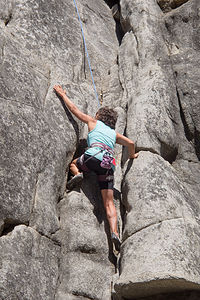 Lolo ClimbingHaving arrived well after midnight the night before after a full day of work, a flight from Seattle (for Tommy), and a long four and a half hour drive in the dark, I mistakenly thought that the boys and Celeste might want to sleep in. Silly me. I apparently have forgotten what it is like to be in your early 20s and on vacation from your first job. They were up at the crack of dawn, rearing and ready to go.
Lolo ClimbingHaving arrived well after midnight the night before after a full day of work, a flight from Seattle (for Tommy), and a long four and a half hour drive in the dark, I mistakenly thought that the boys and Celeste might want to sleep in. Silly me. I apparently have forgotten what it is like to be in your early 20s and on vacation from your first job. They were up at the crack of dawn, rearing and ready to go.
We decided to start that day at a climbing area called Swan Slab, mostly because we were familiar with it from climbing there last Thanksgiving. It had two of the three criteria we were looking for: ease of top-roping and difficulty ratings in the 5.9 – 511a range. There were even some easier climbs for me to attempt, although after the spectacle I made of myself the last time I climbed (and I use the term loosely) here, I wasn’t quite sure if I was ready to show my face there again.
The only problem with this wall was that it might be too hot, as it was in the sun for the majority of the day, which explains why we liked it so much in the cool days of November. However, because most climbers in August head to the higher elevation rock in Tuolumne Meadows or the shadier walls in the Valley, we pretty much had the whole place to ourselves. I definitely liked the idea of fewer spectators.
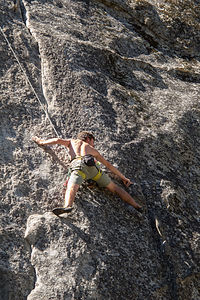 Tom ClimbingSince the climbs here were not “sport” climbs, Tommy, who is the most comfortable leading, would have to put in his own protective pieces on the way up. However, unlike “traditional” climbing where the leader sets up a belay station on the wall from which he belays the other climbers up to him, with top roping the leader climbs up to a secure anchor point, attaches the rope, and then rapels back down, so that both ends of the rope are on the ground, secured above at the anchor point. Then one person belays from the ground as the next climber goes up the route, removing the protective pieces along the way. The reason that it is safer is that the climber can’t fall very far at all, because the belayer has him tight on the other end.
Tom ClimbingSince the climbs here were not “sport” climbs, Tommy, who is the most comfortable leading, would have to put in his own protective pieces on the way up. However, unlike “traditional” climbing where the leader sets up a belay station on the wall from which he belays the other climbers up to him, with top roping the leader climbs up to a secure anchor point, attaches the rope, and then rapels back down, so that both ends of the rope are on the ground, secured above at the anchor point. Then one person belays from the ground as the next climber goes up the route, removing the protective pieces along the way. The reason that it is safer is that the climber can’t fall very far at all, because the belayer has him tight on the other end.
So, here we were, sending out the youngest to set up a top rope by climbing a 5.9 called Grant’s Crack. From there, they were able to top rope a few other 5.9s and 5.10s as well.
To their credit, the boys and Herb are always very encouraging and nurturing to me regarding climbing. I had really put a lot of effort in over the last year to improve my climbing skills. I even joined a climbing gym and have been going three times a week. I was really starting to truly enjoy it for the first time in my life and could actually see myself progressing from week to week.
 Tubing the MercedStill, applying what you learn in a gym to an actual rock wall is not necessarily that easy. However, with their patience and guidance, I actually did climb pretty well, and was able to complete two climbs fairly skillfully, if not necessarily gracefully. They were quite impressed, which made me very proud and happy.
Tubing the MercedStill, applying what you learn in a gym to an actual rock wall is not necessarily that easy. However, with their patience and guidance, I actually did climb pretty well, and was able to complete two climbs fairly skillfully, if not necessarily gracefully. They were quite impressed, which made me very proud and happy.
However, my proudest moment of the trip would come later that day when I unveiled the five Intex River Tubes I had ordered from Amazon – complete with backrests and drink holders. I had remembered from our trip to Yosemite in August of 2007 just how hot the Valley can be, and just how good the Merced River can feel after a long day of physical activity.
Not everyone was initially as enthusiastic as me about my purchase. Due to the very severe drought conditions in California, there was much skepticism amongst the troops as to the feasibility of using these tubes in what would probably be a dried up river. I, however, had been tracking the USGS graphs of water levels and flow in the Valley, and although far from impressive, I knew there was at least a few inches of water in the river. I was not going to let these “Debbie Downers” get in the way of my good time.
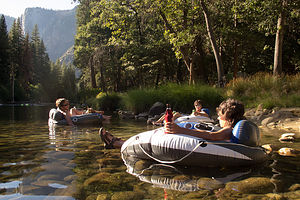 Family TubingSo, after everyone had tired themselves out on the rock (Celeste is always the last to give in), we drove around the Valley Loop to Cathedral Beach, where the views of El Cap are particularly spectacular, and where there seemed to be at least some water in the river.
Family TubingSo, after everyone had tired themselves out on the rock (Celeste is always the last to give in), we drove around the Valley Loop to Cathedral Beach, where the views of El Cap are particularly spectacular, and where there seemed to be at least some water in the river.
Using our brand new car-powered electric pump (also from Amazon), we quickly and effortlessly inflated the tubes – although we did have to blow up the backrests by mouth. The pièce de résistance was my placement of ice cold refreshing beers in the drink holders. I could see by their now enthusiastic faces that I was reaching new heights in motherhood.
I dragged my tube to the river, plopped myself down in about 8 inches of water, and basked in the glow of my sons’ admiration and love for their crazy mother.
Seriously though, I highly recommend these tubes:
http://www.amazon.com/gp/product/B000PEOMC8/ref=oh_aui_detailpage_o03_s0...
Rock Climbing on Church Bowl Wall and the Bergs Arrival
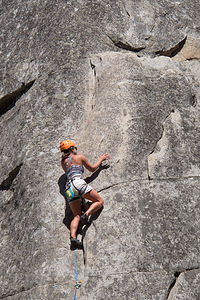 Celeste ClimbingUsually we don’t climb two days in a row, as a rest day in between makes for stronger climbing the next, but since Celeste’s parents were arriving that evening and we would be mostly hiking during their stay, we decided to squeeze in another day of climbing before their arrival.
Celeste ClimbingUsually we don’t climb two days in a row, as a rest day in between makes for stronger climbing the next, but since Celeste’s parents were arriving that evening and we would be mostly hiking during their stay, we decided to squeeze in another day of climbing before their arrival.
This time we chose the Church Bowl Wall, located right behind a picnic area about halfway between Yosemite Village and the Ahwahnee Hotel. Often access to climbing walls involves a lengthy scramble up rocks to get to the base of a cliff, but this area, like Swan Slab was very accessible. Also, If I got bored, I could just take a short walk to the Village to buy a latte or stroll the other direction and hang out in the cozy Ahwahnee living room.
As with the previous day, Tommy led the first climb with the plan to set up a top rope from which to do some other climbs. Unfortunately, about halfway up, he pulled a muscle in his bicep and appeared to be in quite a bit of pain. We lowered him down and I volunteered Herb to set up the route instead. “Thanks dear,” he said and accused me of trying to preserve my gene pool by sending him up instead of our young. I just told him I had faith in him. He did just fine.
They did a few more 5.10s and I even did two climbs as well. Unfortunately, some of the easier graded climbs are what are known as chimneys, which basically means you have to ooch your entire body through very narrow, damp spaces – not quite the elegant and graceful movements I watch Herb, the boys, and Celeste do on the rock. There were times when I could have completely let go with my hands and still not fallen because my butt was wedged so tightly between two rocks that I could barely set it free.
It was kind of secure and cozy in the chimney though, so I chose to continue ooching my way up like a worm rather than go out on the open exposed face of the rock, which, although more intimidating, would probably have been a lot easier.
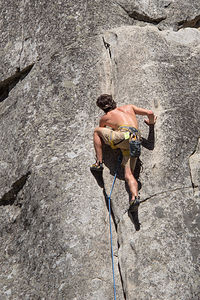 Andrew ClimbingI had pretty much had enough and was starting to picture my butt squeezed into a tube on the river instead of between two rocks. The others were pretty convinced that that sounded pretty good as well.
Andrew ClimbingI had pretty much had enough and was starting to picture my butt squeezed into a tube on the river instead of between two rocks. The others were pretty convinced that that sounded pretty good as well.
On the way back to the campground we stopped at the Village Store to pick up cans of Sierra Nevada Pale Ale, as we always enjoy drinking a beer appropriate to our location – except for the time we bought General Grant Ale in Sequoia National Park because we had visited the Grant Grove of Sequoia Trees. Big mistake – awesome trees, lousy beer.
Back in the campground, we dragged the tubes down to the river, which was only about 50 yards from our campsite, inserted Sierra Nevadas in the cup holders, and floated. Why is it that beer always tastes better after physical activity?
Just when I thought we were in the relaxation phase of the day, Andrew and Celeste decided that they should go bouldering. For those non-rock climbers, bouldering is climbing on small rock formations, or “boulders,” without using ropes. For safety, a bouldering pad is placed below the climber to cushion his fall, which is usually not from a great height. Herb and I had given Andrew and Celeste a bouldering pad for Christmas, so we were happy to see that they were using it. We are such cool parents!
Tommy was torn between a second Sierra Nevada and joining them, but peer pressure won out. So, the three of them took the bikes, with a bouldering pad strapped to Andrew’s back, and rode back to the Church Bowl area to boulder. Like climbs, bouldering routes are also rated based on their difficulty, with V0 being the easiest. Climbing in Yosemite can always be very humbling, so they soon discovered that even doing a Yosemite V0, which they renamed Vbaby, was challenging, especially after a full day of climbing and a Sierra Nevada.
While they were gone, Herb and I drove over to the Ahwahnee Meadow, our favorite place to sip wine and watch sunset in the Valley. There’s nothing like watching the colors change on Half Dome, especially the alpenglow that occurs a little while after sunset.
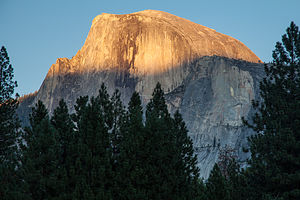 Half Dome SunsetHowever, this time it was not to be. For the first time in over a dozen nights spent partaking of this beautiful scene, over a period of close to 30 years, we were asked to leave the meadow by a pair of Park Rangers. Despite our question as to why we were not allowed to be on what was very obviously a well-established and highly-traveled path through the meadow, they told us that the meadow was now closed for restoration and that there were signs all around the meadow indicating that. We found that strange in that we parked, as always, in the small pullout which was located right by the start of the path that crossed the meadow, and there had been no signs indicating a meadow closure. In fact, this pullout’s only reason for being was for usage of this path. We later confirmed that there were no signs anywhere else around the meadow.
Half Dome SunsetHowever, this time it was not to be. For the first time in over a dozen nights spent partaking of this beautiful scene, over a period of close to 30 years, we were asked to leave the meadow by a pair of Park Rangers. Despite our question as to why we were not allowed to be on what was very obviously a well-established and highly-traveled path through the meadow, they told us that the meadow was now closed for restoration and that there were signs all around the meadow indicating that. We found that strange in that we parked, as always, in the small pullout which was located right by the start of the path that crossed the meadow, and there had been no signs indicating a meadow closure. In fact, this pullout’s only reason for being was for usage of this path. We later confirmed that there were no signs anywhere else around the meadow.
I am very much a proponent of preservation and conservation, but quite frankly, I thought this was just silly and not essential for accomplishing their worthy goal. There are paths crossing most of the meadows in the park, and people respect them by staying on them and off the meadows. Oh well. I guess I was just disappointed that this cherished tradition of ours was over.
That evening, Andrew cooked his delicious Penne Vodka recipe and we kept it warm until Celeste’s parents arrived sometime after 9:00 pm. Afterwards we helped them store their food in the bear box and set their tent up in the dark. We also warned them that they might hear shots during the night as our park volunteer neighbors shot bean bags at bears that were becoming a bit too campground friendly. Once again, I was glad I was in a hard-sided motorhome.
Hiking Taft Point and the Fissures, Sentinel Dome, and Glacier Point
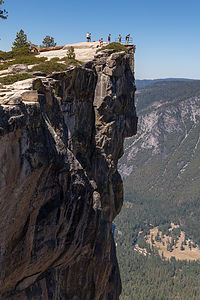 Taft PointDespite this being our 7th visit to Yosemite, there were still plenty of spectacular hikes that we hadn’t done, two of which were the hikes to Taft Point and the Fissures and Sentinel Dome. Their exclusion to date was simply due to the fact that there are so many fantastic hikes right from the Valley, and these two required a 30-mile drive to the trailhead along Glacier Point Road.
Taft PointDespite this being our 7th visit to Yosemite, there were still plenty of spectacular hikes that we hadn’t done, two of which were the hikes to Taft Point and the Fissures and Sentinel Dome. Their exclusion to date was simply due to the fact that there are so many fantastic hikes right from the Valley, and these two required a 30-mile drive to the trailhead along Glacier Point Road.
We obviously weren’t the only ones with this idea. The trailhead parking lot was full, so we joined the dozens of cars parked along the shoulder of the road.
From the trailhead, we chose to go left first through the woods towards Taft Point. I wouldn’t want to do this hike in the dark, because before you get to Taft Point itself, you have to step around the fissures, which are these immense vertical gashes in the granite that plunge hundreds of feet to the Valley—kind of like crevasses minus the snow. There were no guard rails around them, so we were free to get up close and gaze down and down. It still makes my palms sweat thinking about it.
A short distance ahead was Taft Point itself, where we stood at the edge of the cliff –this time with a metal railing – and gazed down at the Valley. From this vantage point, we were actually looking down on El Cap rather than craning our necks skyward to take in its immensity. The view would have been even more spectacular if Yosemite Falls wasn’t dry.
 Herb at the FissuresRather than retrace our steps back to the car, we took the Pohono Trail, which eventually wrapped clockwise around the northern end of Sentinel Dome, bringing us to the backside where we scrambled up its smooth granite surface for about 100 yards to the summit.
Herb at the FissuresRather than retrace our steps back to the car, we took the Pohono Trail, which eventually wrapped clockwise around the northern end of Sentinel Dome, bringing us to the backside where we scrambled up its smooth granite surface for about 100 yards to the summit.
All I can say is that there is an awful lot of bang for your buck on this hike. The hike up the backside of Half Dome is about a 17-mile roundtrip, and the hike to the top of Yosemite Falls is a strenuous 7.4-mile one, but getting to the top of Sentinel Dome takes about 2 miles of level walking and just a brief scramble to the top. And, the views are just as spectacular, if not even more so with El Cap and Yosemite Falls to the north (too bad it wasn’t flowing); Half Dome, Clouds Rest, and Nevada Fall to the east; and the most famous dead tree right there on top of the summit (the one Ansel Adams photographed when it looked a little livelier).
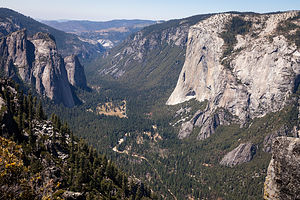 El Capitan View from Pohono TrailWe spent a good deal of our time on the summit photographing various combinations of our party with a spectacular backdrop, but the winning photo in my opinion was the auto-timed shot with the seven of us jumping with glee in the air. The boys were so embarrassed about doing this publicly that Herb only got one shot at it, but thankfully, it was a good one.
El Capitan View from Pohono TrailWe spent a good deal of our time on the summit photographing various combinations of our party with a spectacular backdrop, but the winning photo in my opinion was the auto-timed shot with the seven of us jumping with glee in the air. The boys were so embarrassed about doing this publicly that Herb only got one shot at it, but thankfully, it was a good one.
From Sentinel Dome, we could have just gone back to the car, but we decided to continue on to Glacier Point, which probably was a mistake, because after the relative solitude of the hiking so far, that place was an absolute zoo due to the fact that people could just drive up to it without that annoying hiking thing getting in the way. Plus there was ice cream and a gift shop.
The views at Glacier Point are spectacular as well, but are tainted by the need to elbow yourself into position so you don’t have a group of strangers in your photo.
 Sentinel Dome Jumping HikersFrom there, our party split. At least two of us had to hike back to the cars we had parked near the trailhead on Glacier Point Road, but the rest could take advantage of the opportunity to hike the Four-Mile Trail down to the Valley floor rather than drive. Andrew, Tommy, and Celeste decided to do the hike while their very gracious parents took it for the team and hiked back to the cars. All in all, we hiked 9.3 miles while the kids hiked 11.4 miles. Those steep downhill miles though are much tougher on the knees than the uphill ones.
Sentinel Dome Jumping HikersFrom there, our party split. At least two of us had to hike back to the cars we had parked near the trailhead on Glacier Point Road, but the rest could take advantage of the opportunity to hike the Four-Mile Trail down to the Valley floor rather than drive. Andrew, Tommy, and Celeste decided to do the hike while their very gracious parents took it for the team and hiked back to the cars. All in all, we hiked 9.3 miles while the kids hiked 11.4 miles. Those steep downhill miles though are much tougher on the knees than the uphill ones.
Ironically, the hike back to the car and drive to the Valley took the same exact time as the kids’ hike on the misnamed Four-Mile Trail – it is actually closer to 4 ½ miles. They had just arrived at the bottom when we swung by and picked them up in our cars.
I think we all felt that sense of satisfaction from a great day of strenuous physical activity and awesome views. A very nice ending to the day included Paul cooking pasta and pork sausage that came from his very own pigs. There’s nothing like knowing the name of your dinner.
Hiking Inspiration Point, Tubing from Cathedral Beach, and Dinner at the Ahwahnee Bar
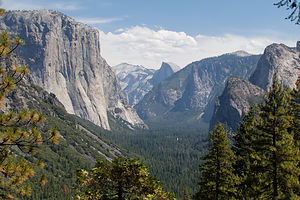 Yosemite Valley View from Inspiration PointWe wanted to pick another classic Yosemite hike to do with Celeste and her family. If the falls in the Valley had been running, we would definitely have chosen to hike the strenuous switchback trail to the top of Yosemite Falls. However, without the spectacular images of water cascading over the granite walls and tumbling down to the Valley, it was just too much work for too little reward.
Yosemite Valley View from Inspiration PointWe wanted to pick another classic Yosemite hike to do with Celeste and her family. If the falls in the Valley had been running, we would definitely have chosen to hike the strenuous switchback trail to the top of Yosemite Falls. However, without the spectacular images of water cascading over the granite walls and tumbling down to the Valley, it was just too much work for too little reward.
Instead we chose another classic – the fairly short (2.6 miles RT), but steep hike to Inspiration Point. The trailhead is at the Wawona Tunnel overlook, where at any given moment you will encounter tour buses dispensing camera-clad tourists anxious to capture this iconic view of the Valley. Its masses rivaled the Glacier Point overlook.
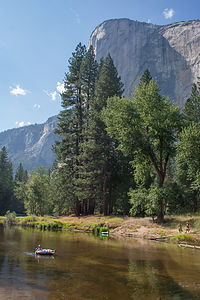 El Capitan View from Cathedral Beach with TuberHowever, as we have discovered in the past, all you need to do is hike a ½ mile to leave the crowds behind. And, if the trail is steep, as the first half mile of this one was, you will practically have it to yourselves within the first 100 yards.
El Capitan View from Cathedral Beach with TuberHowever, as we have discovered in the past, all you need to do is hike a ½ mile to leave the crowds behind. And, if the trail is steep, as the first half mile of this one was, you will practically have it to yourselves within the first 100 yards.
At 1.3 miles we reached “Old Inspiration Point,” which is where the road to Yosemite Valley used to go in the days before the Wawona Tunnel was built. The views are now mostly obscured by trees, but as we discovered last Thanksgiving, if you just hike a short distance down to a lower granite shelf, the views of El Cap, Half Dome, and Yosemite Falls are unobstructed and breathtaking. In fact, this was the site of our 2013 Gaidus Family Christmas Photo.
It seemed like every hike we chose boasted that it had the best views of the Valley. Although they can’t all be the best, they all can be pretty damn spectacular.
The trail doesn’t end at Old Inspiration Point, but continues steeply uphill for another 1,000 foort elevation gain to what I guess is New Inspiration Point.
We debated for awhile as to whether to continue upward or go back to Cathedral Beach and tube in the river. Andrew and Celeste decided to go on and meet up with us at the beach, while the rest of us chose to go down.
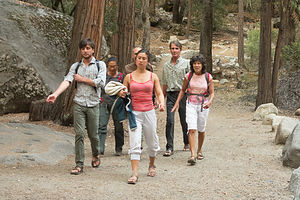 Hiking to the Ahwahnee BarWhile Andrew and Celeste hiked, we drove back to the campground, picked up the motorhome, filled it with water at Upper Pines campground so we could all shower later, made sandwiches, drove to Cathedral Beach, and blew up tubes. Just as all that was done, Andrew and Celeste showed up and joined us.
Hiking to the Ahwahnee BarWhile Andrew and Celeste hiked, we drove back to the campground, picked up the motorhome, filled it with water at Upper Pines campground so we could all shower later, made sandwiches, drove to Cathedral Beach, and blew up tubes. Just as all that was done, Andrew and Celeste showed up and joined us.
Although the water in the Merced was painfully low, we still were able to float a bit and soak up the views, this time from below looking up. I was still gloating about these tubes.
That evening, after some very quick, cold showers (something was wrong with the motorhome’s water heater), we walked from the campground to the Ahwahnee Hotel to have dinner on the outdoor patio of the Ahwahnee Bar. We had to wait a pretty long time for a table for 7, but eventually were seated just as it was getting dark. The bar menu is fairly limited compared to the Dining Room, but we were able to find something to our liking. I just love being anywhere in the Ahwahnee, especially with my favorite people in the world.
Hiking to Vernal and Nevada Falls, Berg’s Departure, and Yosemite Theater Live
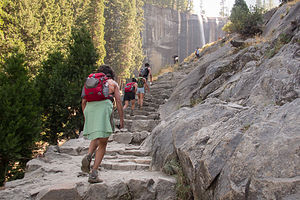 Hiking to Vernal FallsThis was Celeste and her parents’ last day in Yosemite, because Celeste had to get back to work. Mistakenly, I thought they would want to get going by late morning to make the 4 ½-hour drive back to San Francisco, but being as active (if not more so) a family as we are, I should have realized that they would want to squeeze out one more classic Yosemite hike.
Hiking to Vernal FallsThis was Celeste and her parents’ last day in Yosemite, because Celeste had to get back to work. Mistakenly, I thought they would want to get going by late morning to make the 4 ½-hour drive back to San Francisco, but being as active (if not more so) a family as we are, I should have realized that they would want to squeeze out one more classic Yosemite hike.
The day began the way every day should, with Paul cooking fresh eggs from his very own chickens and bacon and sausage from his ex-pigs. Wonderful aromas like this normally don’t emanate from our campsite.
After a delicious and very filling start to our day, we packed a lunch and walked about a mile from the campground to Happy Isles, the trailhead for the Mist Trail to Vernal and Nevada Falls. This is one of the most popular climbs in the Valley, so we had no expectations of finding solitude on the trail, but even we were surprised by the steady stream of people of all ages, shapes, sizes, and foot gear. We even passed two people (in separate groups) carrying soccer balls and one with a football. I can’t even imagine any scenario where this would have made sense.
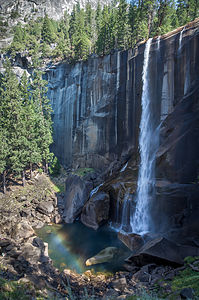 Vernal Falls with Rainbow at BaseThe trail is named the Mist Trail, because the mist from the falls normally sprays hikers and the trail itself, often making it quite slippery. However, due to the severe drought in California and the lateness of the summer, the falls were a mere shadow of their former selves. I am sorry to report that there was no mist on Mist Trail, but at least there was some water cascading over the falls, while the rest of the falls in the Valley were dry. This might also explain the hordes of hikers on this trail.
Vernal Falls with Rainbow at BaseThe trail is named the Mist Trail, because the mist from the falls normally sprays hikers and the trail itself, often making it quite slippery. However, due to the severe drought in California and the lateness of the summer, the falls were a mere shadow of their former selves. I am sorry to report that there was no mist on Mist Trail, but at least there was some water cascading over the falls, while the rest of the falls in the Valley were dry. This might also explain the hordes of hikers on this trail.
The first mile of the trail is partially paved and almost entirely uphill. After 0.8 miles and about a 500-foot elevation gain, we came to the Vernal Falls footbridge where there is a good view looking up at the falls. After crossing the bridge, in about 0.2 miles we came to a junction in the trail, with the Mist Trail continuing to the left and the John Muir Trail to the right. We planned to do a loop, so we followed the Mist Trail up a steep granite staircase with over 600 steps to the top of Vernal Falls. There’s nothing like strenuous physical activity to thin a crowd, so already we were finding ourselves with a bit more peace and solitude.
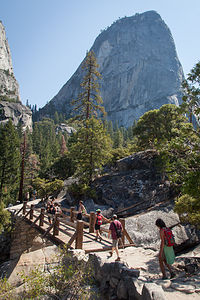 Hiking the Mist Trail to Nevada FallsThe staircase comes pretty close to the falls, so this is where you normally get soaked. From the top of Vernal Falls, you can stand behind metal railings, and look straight down the length of the 317-foot waterfall. Although it didn’t look terribly fierce today, far too many foolish tourists, trying to get the ultimate photo, have climbed over the railings and been swept away over the edge.
Hiking the Mist Trail to Nevada FallsThe staircase comes pretty close to the falls, so this is where you normally get soaked. From the top of Vernal Falls, you can stand behind metal railings, and look straight down the length of the 317-foot waterfall. Although it didn’t look terribly fierce today, far too many foolish tourists, trying to get the ultimate photo, have climbed over the railings and been swept away over the edge.
Just beyond the top of the falls, the Mist Trail led passed the Emerald Pool, where there were happy swimmers ignoring the Danger No Swimming signs. I have to admit that in 2007 on our way down from the strenuous hike up the Half Dome Cable Route, we did take a refreshing dip in this Pool, but far, far away from where the current was strong – still no excuse.
Right past the Emerald Pool, we crossed a bridge back over the Merced and began the 1 ½ mile climb up steep, rocky switchbacks, with Liberty Cap to our left and Nevada Falls slipping in and out of view ahead.
At 2.8 miles (and an elevation gain of 2,600 feet), the Mist Trail came to an end and joined with the John Muir Trail. Straight ahead was the trail to the Half Dome Cable Route, which we did back in 2007, but this time we took the John Muir Trail to the right and crossed a footbridge over Nevada Falls, with railings to hold onto while gazing down its 594-foot plunge.
 Nevada Falls with HikersFrom this point, we could either retrace our steps back down the Mist Trail for 2.8 miles, or continue on the John Muir Trail for 4 miles as an alternate route down to the Valley. We all preferred a loop-hike, so we unanimously decided to continue on the John Muir Trail.
Nevada Falls with HikersFrom this point, we could either retrace our steps back down the Mist Trail for 2.8 miles, or continue on the John Muir Trail for 4 miles as an alternate route down to the Valley. We all preferred a loop-hike, so we unanimously decided to continue on the John Muir Trail.
But before doing so, we decided that this was a perfect stop for lunch. We pretty much had left about 90% of the hikers behind, so the only thing we had to contend with were the very aggressive squirrels anxious for a little bit of lunch themselves.
We also took this opportunity to perfect our group jumping shot. Herb dutifully set up his camera on a tripod, lined us up, and on the count of 3 we all leaped in the air as high as we could. This time the kids let us take several shots from which to pick the best. Some of them were hysterical. For some reason, Tommy got the idea that kicking his leg up in the air would be amusing, but unfortunately this required pushing the person next to him, which of course was me, downward to achieve his ultimate height. It made me look like a munchkin.
The hike down the John Muir Trail was a little less scenic and less crowded than the Mist Trail. There was, however, a particularly nice view of Nevada Falls with Liberty Cap in the background.
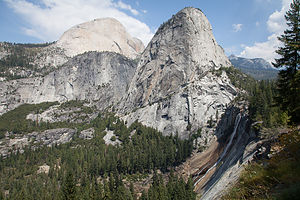 Liberty Cap, Nevada Falls, and Back of Half DomeOnce back at Happy Isles, we decided to take a more scenic route back to the campground, but we got a bit lost and wound up passing the Ahwahnee and having to go across the Ahwahnee Meadow to get back to the campground. This made our total hiking distance 9.9 miles, with over 2,600 feet of elevation gain.
Liberty Cap, Nevada Falls, and Back of Half DomeOnce back at Happy Isles, we decided to take a more scenic route back to the campground, but we got a bit lost and wound up passing the Ahwahnee and having to go across the Ahwahnee Meadow to get back to the campground. This made our total hiking distance 9.9 miles, with over 2,600 feet of elevation gain.
Back at the campsite, Celeste and her parents packed up and left to drive back to San Francisco. They added so much to our trip, and we would certainly miss them, and not just because of Paul’s sausages and bacon.
That evening we did something I have wanted to do every visit to Yosemite, but somehow never managed to squeeze in – attend a performance at the Yosemite Theater Live. It seems like we were always too busy chasing sunsets, but this time I said that I should get to pick how an evening was spent.
It was such an unbelievably worthwhile experience. Every Wednesday night since 1983, the actor Lee Stetson has been playing the role of John Muir in a presentation entitled “Conversation with a Tramp: An Evening with John Muir.” Tickets for the live performance were only $8 and can be purchased at the Visitor Center.
 Lolo Attacking the Manure Buttress PileFor over an hour we were mesmerized and completely absorbed in the self-reflections of this great man who did so much to preserve Yosemite for all of us to enjoy. Stetson was incredibly convincing in his role as he rambled on about his childhood, his obsession with the beauty of Yosemite, and his efforts to save Hetch Hetchy, which sadly failed. The performance, which Stetson wrote entirely himself, included his reception and reaction to the news that more politically powerful men had won the battle for Hetch Hetchy.
Lolo Attacking the Manure Buttress PileFor over an hour we were mesmerized and completely absorbed in the self-reflections of this great man who did so much to preserve Yosemite for all of us to enjoy. Stetson was incredibly convincing in his role as he rambled on about his childhood, his obsession with the beauty of Yosemite, and his efforts to save Hetch Hetchy, which sadly failed. The performance, which Stetson wrote entirely himself, included his reception and reaction to the news that more politically powerful men had won the battle for Hetch Hetchy.
At the end of the performance, Stetson spoke to the audience and mentioned that he was available to speak at schools, communities, or wherever people were interested in hearing his message. The boys tried to get me to hire him to have Thanksgiving dinner with us, which we are actually doing at the Ahwahnee this year. Wouldn’t that be something?
Rock Climbing on Manure Buttress Pile and Hanging out at the Ahwahnee
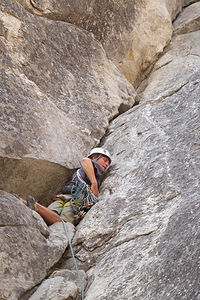 Tommy on Lead at the Manure ButtressThis was our first day back rock climbing after three rest days, if you can call strenuous hiking a rest.
Tommy on Lead at the Manure ButtressThis was our first day back rock climbing after three rest days, if you can call strenuous hiking a rest.
For today’s adventures we chose the alluringly-named Manure Buttress Pile wall, just east of El Cap on the north side of the Valley. Like the other walls we had selected, this one had an easy approach, a selection of climbs in the 5.9 – 5.11a range, and the ability to set up a top rope.
Just to set the record straight, there was no hint or whiff of manure anywhere near this very nice 600-foot rock formation. Perhaps the name was a convenient way of keeping away the crowds.
Actually, I did a little digging (no pun intended) and found out that in the old days when horses were the only way to get to the park, the park service used to collect all the horse manure in the Valley and bring it to the base of this rock for disposal. Thankfully, Henry Ford’s Model T’s eventually eliminated manure production and disposal and replaced it with traffic jams. Progress isn’t always a good thing.
After a very satisfying day of climbing, even for me, we went back to the campground, barbecued pork chops, and then headed over to the Ahwahnee, with a deck of cards and kindles in hand, to settle in their comfortable sitting area. Hanging out in this sitting room is especially nice during our Thanksgiving visits, because the days are shorter and there isn’t much to do after nightfall, and this place is really, really cozy. Actually, it’s pretty cozy any time of year.
Hiking to North Dome
 Family with Faux Dad Rock Cairn on route to North DomeOver the years, we had pretty much hiked all of the classic trails from the Valley, but had not spent much time up along the Tioga Pass Road. In fact, I don’t think the boys had even been up to Tuolumne and Tioga Pass, except to drive through went entering the park through the East Entrance.
Family with Faux Dad Rock Cairn on route to North DomeOver the years, we had pretty much hiked all of the classic trails from the Valley, but had not spent much time up along the Tioga Pass Road. In fact, I don’t think the boys had even been up to Tuolumne and Tioga Pass, except to drive through went entering the park through the East Entrance.
When researching hikes before leaving on this trip, I originally selected Clouds Rest as a must do. However, after looking a little further, I found that the final summit ascent is only about 4 feet wide and has terrifying drop-offs on either side. I even tried to watch You-Tube videos that people posted of this section, and my palms sweated every time. Then I even googled deaths on Clouds Rest to reassure myself that it was perfectly safe and found that a 53 year old woman fell to her death—and I am a much more feeble 58. I told Herb that, call me a weenie if you will, but I just couldn’t do it.
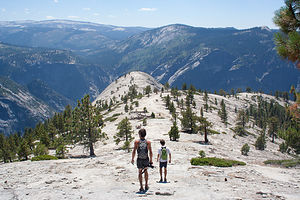 Boys on Final Approach to North DomeSo, that’s when I found the North Dome hike, a great alternative in that it had just as spectacular views, without the risk of death. I now had new criteria for selecting a hike. Plus, oddly enough, since the Tioga Pass road is so high, the final hike to the summit of North Dome is actually a descent.
Boys on Final Approach to North DomeSo, that’s when I found the North Dome hike, a great alternative in that it had just as spectacular views, without the risk of death. I now had new criteria for selecting a hike. Plus, oddly enough, since the Tioga Pass road is so high, the final hike to the summit of North Dome is actually a descent.
The drive to the trailhead at Porcupine Creek was about 43 miles from our campground in the Valley and took us close to an hour and a half because of road construction. We were still pretty early though, so fortunately there were a few spots left in the parking area.
Unlike the other hikes we had done this week, the trail started down rather than up, which it continued to do for about a mile through a lovely, quiet pine forest. There was no one else around, so it was very, very peaceful – a much different experience than the crowded Mist Trail.
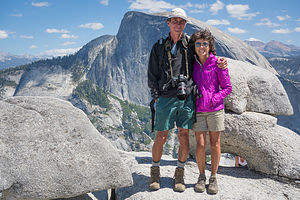 Lolo and Herb at North Dome with Half Dome and Boobs under RockAt about the mile and a half mark, we came to a trail junction – straight ahead to North Dome and a left to the Valley Floor via Tenaya Canyon. On the way back from North Dome, we would split up at this point, with Tommy and me going back to the car, and Andrew and Herb hiking down to the Valley.
Lolo and Herb at North Dome with Half Dome and Boobs under RockAt about the mile and a half mark, we came to a trail junction – straight ahead to North Dome and a left to the Valley Floor via Tenaya Canyon. On the way back from North Dome, we would split up at this point, with Tommy and me going back to the car, and Andrew and Herb hiking down to the Valley.
However, for now, we all continued on together as the trail began to ascend Indian Ridge. At about 2.5 miles we came to another junction for the side trip to Indian Rock. We decided to skip that for now and hit it on the way back if we still had the energy.
As the trail made its way up the ridge, we came to a big flat granite area that I at first thought was North Dome, but realized we hadn’t gone far enough yet. I knew that because whenever we hike I clutch a GPS that tells me how far we’ve gone, what our elevation is, etc. I use it for reinforcement that I am actually making progress. This false North Dome was just a treeless portion of Indian Ridge.
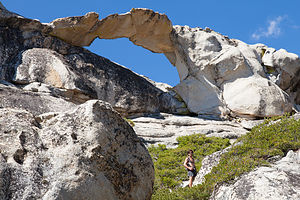 Indian Rock ArchNow that we were out of the trees, the views were getting really good, and as we continued on, they just kept getting better and better. Eventually, we saw the real North Dome, a huge smooth granite plateau jutting out before us.
Indian Rock ArchNow that we were out of the trees, the views were getting really good, and as we continued on, they just kept getting better and better. Eventually, we saw the real North Dome, a huge smooth granite plateau jutting out before us.
At 4.5 miles, we took the left spur for the hike down (that’s right, down) to the summit of North Dome. The winds had really picked up, making our trek across this spectacular rock even more dramatic. It seemed like the whole world lay before us – Clouds Rest and Tenaya Canyon to the northeast, Yosemite Valley below, and our old favorite Half Dome just across the canyon.
This was a totally different perspective of Half Dome than we had ever seen. It looked much wider than usual. We finally figured out that this time we were looking at it head on, and all our other views of it, like from the Valley or Glacier Point, were from an oblique angle that shortened it. It was kind of like getting used to an old friend that you hadn’t seen in awhile that had gained weight.
 Half Dome view from Dry Mirror LakeFinally, we pried ourselves away and began our ascent off the Dome. On the way back, we took the steep ¼-mile spur trail to Indian Rock, the only natural arch in Yosemite.
Half Dome view from Dry Mirror LakeFinally, we pried ourselves away and began our ascent off the Dome. On the way back, we took the steep ¼-mile spur trail to Indian Rock, the only natural arch in Yosemite.
When we got back to the junction to hike down to the Valley, I tried to convince them all to take it and I would drive the car back. Tommy sweetly said he would keep me company, and Herb and Andrew went off on their own adventure, adding another 5 or 6 miles to an already long 9-mile hike.
Tommy and I were back at the campsite for quite awhile, and it was almost dark before Herb and Andrew eventually wandered in, tired but happy. They said it was absolutely spectacular, but a very steep descent – after all they had to descend almost 4,000 feet in those 5 extra miles. In fact, it is the steepest trail to the Valley. However, what they will always remember most from this hike was the large rattlesnake that Andrew almost stepped on. No matter how old you are, in times like tha,t you’re always glad your dad is nearby.
Rock Climbing on Glacier Point Apron and Yosemite Theater Live
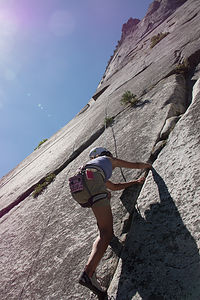 Lolo Climbing at Glacier Point ApronOur last full day in Yosemite with the boys—it was sad in a way, but I am so, so grateful that they still want to spend some of their vacation time with us.
Lolo Climbing at Glacier Point ApronOur last full day in Yosemite with the boys—it was sad in a way, but I am so, so grateful that they still want to spend some of their vacation time with us.
Since yesterday was a hiking day, today must be a rock climbing one. The selection for the day’s activities was the Glacier Point Apron, a massive granite slab that slopes upward towards Glacier Point. Our only hesitancy at first was that the guide book listed this as having potential for rock falls. I was actually more worried about the throngs of tourists atop Glacier Point dropping a latte on my head. In either case, we decided we would where our helmets all day and keep a keen lookout.
The objective for the day was for Andrew to do his first multi-pitch climb, which was a lot more involved than sport climbing or top-roping and required a much more experience, which Tommy and Herb had, and Andrew very much wanted to gain.
Unlike top rope climbing, where a climber climbs up and sets the rope through an anchor and then comes down, in a multi pitch climb, the leader (in our case Tommy) climbs up to a belay station (usually a ledge), anchors himself in, and then belays the other climbers up from there. Then the process is repeated up to the next belay station and so one, for the number of pitches in the climb.
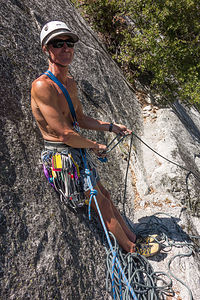 Herb Belaying at First Pitch of "Harry Daley"Before doing the multi-pitch climb, we warmed up on an area called the Goblet, which is known for its slab climbing. Slab climbing is done on rock walls that are not strictly vertical, but slope at angles less than 90 degrees. The holds tend to be really small, so it is a great place to practice balance and friction climbing. Tommy quickly set up a top rope and we were able to practice on different variations ranging from 5.6 to 5.9.
Herb Belaying at First Pitch of "Harry Daley"Before doing the multi-pitch climb, we warmed up on an area called the Goblet, which is known for its slab climbing. Slab climbing is done on rock walls that are not strictly vertical, but slope at angles less than 90 degrees. The holds tend to be really small, so it is a great place to practice balance and friction climbing. Tommy quickly set up a top rope and we were able to practice on different variations ranging from 5.6 to 5.9.
Now that I had gotten climbing out of my system for the day and they were warmed up, we moved right along the cliff base to the base of a classic Yosemite climb called Harry Daley, a 5-star climb that is considered one of the best two-pitch 5.8 climbs in Yosemite.
It’s a bit more time-consuming to do a multi-pitch climb, and all the climbers do disappear upwards, so I brought my Kindle along to entertain me while they were gone. I could also watch them for most of their climb.
At the end of the climb, they each had to rappel down to the belay station below them, and then again down to the ground. Ironically, many climbing accidents occur while belaying, so it is something that also requires knowledge and experience.
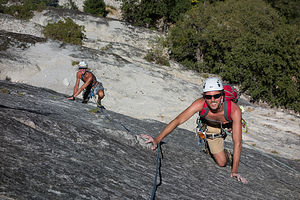 Andrew and Herb Simul Climbing "Harry Daley"They came back exhilarated. Andrew was absolutely ecstatic over his first multi-pitch climb.
Andrew and Herb Simul Climbing "Harry Daley"They came back exhilarated. Andrew was absolutely ecstatic over his first multi-pitch climb.
That evening we went back to the Yosemite Live Theater, this time to see a presentation called “Return to Balance: A Climber’s Journey,” which gave a climber’s perspective of Yosemite. It was give by Ron Kauk, a renowned Yosemite climber. It seemed a very appropriate ending to our week of climbing in the Valley. .
Afterwards, we had pizza at Degnan’s Loft in nearby Yosemite Village and then headed back to the motorhome to call it a night
Ahwahnee Brunch, Andrew and Tommy’s Departure, and Crane Flat
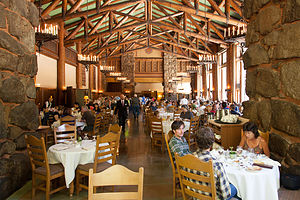 Brunch at the AhwahneeThe boys had to leave today, but not before we squeezed in one more classic Yosemite event—Sunday brunch in the Ahwahnee’s Great Dining Hall, an experience everyone should have at least once in their life. I was shooting for a dozen.
Brunch at the AhwahneeThe boys had to leave today, but not before we squeezed in one more classic Yosemite event—Sunday brunch in the Ahwahnee’s Great Dining Hall, an experience everyone should have at least once in their life. I was shooting for a dozen.
As usual, we requested a table in the alcove at the back of the dining room, where there were views of the granite walls through the floor-to-ceiling windows– you think we would have had enough of rock walls by now.
Once again we were seated next to the Queen’s Table, where Queen Elizabeth had dined during a visit here, but no matter where you sat, you felt like royalty. The food was ample and delicious, the service was impeccable, and the atmosphere was beyond compare. The company wasn’t too bad either.
Well, it was time for the boys to get back to work, so they said their good-bye’s and headed back to San Francisco, and then onto Seattle for Tommy.
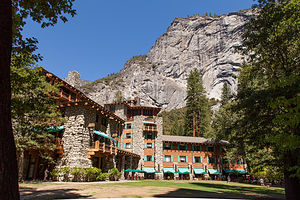 Ahwahnee HotelI had reserved a campsite in the Crane Flat Campground for that night, so we wouldn’t have to rush the boys off early or drive too far afterwards. It was only about a 20 mile drive.
Ahwahnee HotelI had reserved a campsite in the Crane Flat Campground for that night, so we wouldn’t have to rush the boys off early or drive too far afterwards. It was only about a 20 mile drive.
Now, it was just the two of us on our own, with another two weeks to explore the Eastern Sierras. We hadn’t locked ourselves into any specific plans yet, but we had a pretty good idea of places we would like to see and things we wanted to do.
One thing we had never done in all of our trips to Yosemite was to camp in Tuolumne Meadows, so we decided to wake up early and try to nab one of the first-come,-first-served campsites.
It had been a pretty exhausting week trying to keep up with the boys, so going to bed early seemed like a very good idea.
Hiking May Lake – Mount Hoffman and Tuolumne Meadows
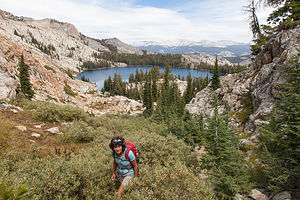 Lolo Hiking with May Lake in BackgroundThe next morning, as planned, we woke early, drove the 40 miles to the Tuolumne Meadows Campground, and were able to get a campsite.
Lolo Hiking with May Lake in BackgroundThe next morning, as planned, we woke early, drove the 40 miles to the Tuolumne Meadows Campground, and were able to get a campsite.
After a brief nap, we looked out the motorhome windows and saw cloudy skies and people dressed in winter jackets and hats. I can’t even begin to tell you how much Herb hates cloudy, cold, damp weather. What a difference from the sunny skies and 90+ temperatures of the Valley. We were 4,600 feet higher than the Valley, but still, this seemed like we had entered a completely different season.
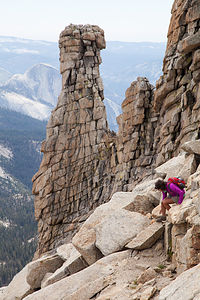 Lolo being "Extreme" on Mount HoffmanWe originally thought we would kayak in Tenaya Lake, but neither of us had any desire to do so in the cold, so we decided to do a hike instead. We chose another hike that was praised for its tremendous views – is there any other kind of hike in Yosemite? – the 6-mile May Lake and Mount Hoffman hike. Located at the geographical center of Yosemite, the promised 360 degree views from its summit sounded amazing.
Lolo being "Extreme" on Mount HoffmanWe originally thought we would kayak in Tenaya Lake, but neither of us had any desire to do so in the cold, so we decided to do a hike instead. We chose another hike that was praised for its tremendous views – is there any other kind of hike in Yosemite? – the 6-mile May Lake and Mount Hoffman hike. Located at the geographical center of Yosemite, the promised 360 degree views from its summit sounded amazing.
We had done three 10-mile hikes last week, so 6 miles seemed relatively trivial, or so we thought. We had overlooked two factors. Firstly, we would be starting at 8,710 feet (just 100 feet shy of the summit of Half Dome), and secondly, we would be climbing 2,000 feet, 1,500 of which were in the last mile and a half.
The first part of the hike to May Lake was quite easy, with only a 500 foot elevation gain over 1.3 miles. The lake was very pretty, with the striking granite cliffs of Mt. Hoffman serving as a backdrop.
There was much activity here as this is the location of one of the five Yosemite High Sierra Camps. This would be fun to do sometime. The camps are spaced about 6 to 10 miles apart on a scenic loop through the High Sierras, and provide sleeping accommodations, as well as a full dinner and breakfast to its guests. As with most things that sound wonderful in Yosemite, reservations for these camps are in very high demand and available only on a lottery basis.
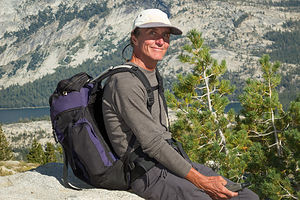 Herb on Mount Hoffman HikeFrom the lake, we were a little confused as to which way to go around it, but another hiker confirmed that we should head left around the lake. Now the trail began to steadily climb in earnest. As we trudged on through a meadow and talus gardens, we were began to be treated to views of Half Dome to the south.
Herb on Mount Hoffman HikeFrom the lake, we were a little confused as to which way to go around it, but another hiker confirmed that we should head left around the lake. Now the trail began to steadily climb in earnest. As we trudged on through a meadow and talus gardens, we were began to be treated to views of Half Dome to the south.
The trail became rockier as we approached the top, and we soon became more than a bit confused as to the proper route to the summit. We tried to follow the cairns, but often there were cairns pointing us in different directions. No matter which way we went, much rock scrambling was required for the last ¼ to summit. I found myself using both hands and even an occasional butt to make my way up to the top.
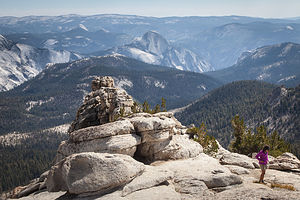 Half Dome from Mount Hoffman SummitThere are actually a couple of false summits, but we did manage to find our way to the true one, which had a radio antenna on top. The 360 degree panoramic view was as spectacular as promised, with every major peak and feature in the park visible.
Half Dome from Mount Hoffman SummitThere are actually a couple of false summits, but we did manage to find our way to the true one, which had a radio antenna on top. The 360 degree panoramic view was as spectacular as promised, with every major peak and feature in the park visible.
We had lunch at the summit and a cute little marmot joined us, looking for a handout.
For some reason, navigating our way down through the talus field seemed easier than the way up. In fact, the whole hike seemed easier on the way down, except that it was a little tough on the knees.
I was so tired that by the time we got back to the car I could hardly complete full sentences and felt I only had the strength to grunt. I think it was the accumulation of so many consecutive days of long hikes and climbing. I definitely needed a rest day tomorrow.
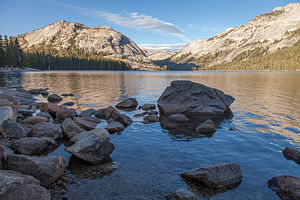 May LakeThe next morning we toyed with whether to spend another day in Tuolumne Meadows or continuing east out of the park to Mammoth Lakes. Since it was still a bit too cool to kayak, and I desperately needed a rest day from hiking, we decided to move on.
May LakeThe next morning we toyed with whether to spend another day in Tuolumne Meadows or continuing east out of the park to Mammoth Lakes. Since it was still a bit too cool to kayak, and I desperately needed a rest day from hiking, we decided to move on.
Up until now, Herb had put our motorhome brake problems to the back of his mind while we had fun with the boys, but now that we actually had to move the motorhome through mountain passes, the issues definitely came full front and center again. Not knowing whether the brake calipers would stick again, we stopped at every pullout on our drive along Tioga Road through the Pass towards the East entrance to the park to take a temperature reading of the brakes. Needless to say, although things seemed okay, the drive was very stressful and nerve-racking.
We headed south on Highway 395 towards Mammoth Lakes.
Description
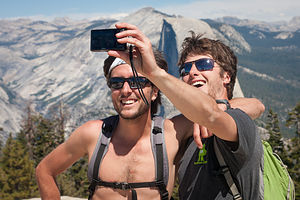 Tom's Sentinel Dome Summit SelfieYosemite National Park lies near the eastern border of California in the heart of the Sierra Nevada Mountains. Its spectacular waterfalls, soaring granite cliffs, and lush meadows are just a few of the reasons it is considered by many to be nature’s ultimate masterpiece. In the words of John Muir, “it is surely the brightest and the best of all the Lord has built.”
Tom's Sentinel Dome Summit SelfieYosemite National Park lies near the eastern border of California in the heart of the Sierra Nevada Mountains. Its spectacular waterfalls, soaring granite cliffs, and lush meadows are just a few of the reasons it is considered by many to be nature’s ultimate masterpiece. In the words of John Muir, “it is surely the brightest and the best of all the Lord has built.”
This description will focus on Yosemite Valley, which is the section of the park we visited. Although the Yosemite Valley is just a small portion of Yosemite’s 761,268 acres, it is part receives 95% of its visitors. In fact, an estimated 4.1 million people visit the Valley each year, making it extremely crowded.
Two one-way roads traverse Yosemite Valley: the east-bound Southside Drive and the west-bound Northside Drive, which wind through woodlands and meadows along the base of the 3,000-foot-high granite cliffs. As of today, cars are still allowed to enter and drive through the valley, but visitors are highly encouraged to park their vehicles and use the park’s free shuttle bus, which stops at the major attractions in the valley.
Virtual Tour of Yosemite Valley Highlights
- As you enter the valley, the first sight you’ll see is the 620-foot Bridalveil Falls flowing down from a hanging valley to the valley floor. From the parking area, a short paved path leads to the base of the falls. This is one of the few falls in Yosemite that does not completely dry up in the summer.
- Just past the Bridalveil Fall parking area, the Southside Drive begins to trace the Merced River. Soon El Capitan comes fully into view. This 3,000 foot high granite cliff is the largest single piece of exposed granite in the world and one of the most famous landmarks in Yosemite. If you look closely, you might see small dots that are actually rock climbers along its face.
- Continuing east on the Southside Drive are two riverside picnic areas and beaches: Cathedral Beach and Sentinel Beach.
- Right after the Sentinel Beach parking area is the trailhead for the 4-Mile trail, which ascends more than 3,200 feet from the valley floor to Glacier Point and one of the most spectacular views of the valley.
- A short distance further is Swinging Bridge, another picnic and swimming area. This area is also the westernmost point of the 8-mile bicycle loop that goes through the eastern part of the valley. From this point on, the bike path parallels the road.
- Next stop is the picturesque tiny Yosemite Chapel where many outdoor enthusiasts choose to exchange wedding vows.
- Now you enter the congested and developed portion of the valley.
- Right past the chapel, you can either take a left onto Sentinel Bridge towards Yosemite Village and the park exit, or you can continue straight towards Curry Village, the campgrounds, and Happy Isles Nature Center. For now, let’s stop at Sentinel Bridge for what is probably the most spectacular Half Dome viewpoint in the park. It’s a great spot for a photograph of Half Dome with the Merced River in the foreground.
- Continuing east on the Southside Drive, you pass Housekeeping Camp and Curry Village. Curry Village has lodging, restaurants, bicycle and raft rentals, a grocery store, and other shops. Curry Village is also one of the main parking areas in the valley.
- From Curry Village you can either take Northside Drive across the Ahwahnee Bridge back to Yosemite Village and the park exit, or continue east to the campgrounds. The Happy Isles Nature Center is also this way, but only shuttle buses are allowed on the road to it.
- The Happy Isles Nature Center features exhibits on the natural history of the park. It also serves as the trailhead for some of the best hikes in Yosemite. 1.5 mile trail leads to the top of Vernal Falls and then continues another 1.5 miles to the top of Nevada Falls (two waterfalls that flow even in the summer time). From there you can continue even further into the backcountry of Yosemite, including the cable route up the back of Half Dome.
- From Curry Village, the Northside Drive crosses the Ahwahnee Meadow, a wonderful spot to gaze at Half Dome during sunset, and enters Yosemite Village, the main center of visitor services in the park. Here you’ll find the park’s main Visitor Center, restaurants, lodging, shops, a grocery store, a post office, a medical clinic, the Ansel Adams Gallery, an Indian Cultural Exhibit and more. It’s also a good place to park your car and jump on the shuttle.
- A short dead end road from Yosemite Village leads to the majestic old Ahwahnee Hotel, which has played host to Queen Elizabeth, President John F. Kennedy, and Clint Eastwood, to name a few. This beautiful six-story rock structure offers tremendous views from every room. Within the hotel is the elegant and quite expensive Ahwahnee Dining Room (jackets required for dinner).
- Back on the Northside Drive heading west from Yosemite Village, the next stop is the Yosemite Falls parking area. At 2,425 feet, Yosemite Falls is the highest waterfall in North America. It is actually three waterfalls in one, with an upper, middle and lower section. A short walk from the parking lot along a paved walk leads to the base of Lower Yosemite Falls. This is the most visited landmark in the valley. Except in summer when the fall temporarily dries up, you’ll be sure to be covered in spray.
- A little further west on the Northside Drive is Yosemite Lodge, which marks the end of the developed area of the park going west.
- Right after Yosemite Lodge is Sunnyside Campground/Camp 4, a place where most rock climbers choose to congregate. From this campground begins the popular and strenuous Yosemite Falls hike, which ascends 2,600 feet from the valley floor to the top of the Upper Falls. The views from the top are incredible.
- Continuing west, there is nothing but woods and meadows from which to enjoy the views. Along the road there are several pullouts where you can stop and walk down to the Merced River for a swim. Just after the El Capitan Bridge, you’ll come to the El Capitan Meadow where you’re sure to find people looking through binoculars at the miniscule rock climbers clinging to the granite face.
- Just to the west of El Capitan, Ribbon Falls plunges over 1,600 feet down to the valley floor. It is the seventh highest waterfall in the world. However, it too dries up in the summer time.
- Finally the road nears the end of the Northside Drive at Valley View where El Capitan, on the left, and Cathedral Rocks, on the right, frame a magnificent valley view.
Several guided bus tours are also available. The 2-hour Valley Floor Tour is a great way to get acclimated. Visitors ride through the valley in an open tram while a guide leads a informative discussion of Yosemite’s history and geology. There are many photo stops along the way. In addition, there are bus tours out of the valley to Glacier Point, the Mariposa Grove of sequoia trees, and Tuolumne Meadows.
Although much of Yosemite can be enjoyed from the comforts of your car or a shuttle, the best way to truly experience Yosemite is do get out and experience it more directly.
Things to do in Yosemite
- Hike one of the many trails around the valley, ranging from an easy walk to the base of Lower Yosemite Falls to the strenuous 16-mile round trip hike up the back of Half Dome via cables
- Take an overnight backpacking trip
- Bike along the 12 miles of bicycle paths that loop through the Valley. Rentals are available at Curry Village and Yosemite Lodge.
- Rock climb in one of the premier climbing places in the world
- Raft down the calm waters of the Merced River through the valley. Rentals are available at Curry Village.
- Swim or tube in the Merced River. Besides the designated beaches, there are many pullouts along the road from which you can walk down to the river.
- Join one of the many ranger walks, which are offered daily
- Take a free art class at the Yosemite Art and Education Center
- Photograph the amazing scenery of the valley and surrounding granite cliffs
- Browse the Ansel Adams Gallery and see some of the photographs that first made Yosemite famous
- Relax in the meadow while gazing up at Half Dome or El Capitan
- Dine at the 5-star Ahwahnee Hotel, where presidents and royalty have stayed
Although many try to see Yosemite in a day, it is best to devote several days to seeing all the park has to offer. Besides the numerous hotels, lodges, and cabins in the Valley, there are three RV campgrounds: Upper Pines (238 sites), Lower Pines (60 sites), and North Pines (81 sites). That’s less than 400 campsites to accommodate all the people that want to camp here.
Since these campgrounds usually fill-up within the first hour they become available, it is essential to make your reservations as soon as possible. Campground reservations are available in blocks of one month at a time, up to five months in advance, on the 15th of each month at 7 am Pacific time. For example, if your arrival date is July 15 through August 14, the first day you can make reservations is March 15. The National Park Reservation System can be found at www.recreation.gov. Good luck!
- ‹ previous
- 2 of 8
- next ›
Yosemite National Park location map in "high definition"
Javascript is required to view this map.
